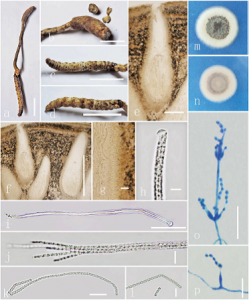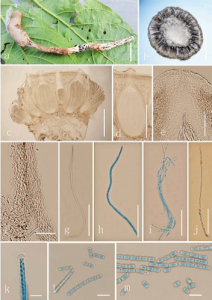Metacordyceps neogunnii T.C. Wen & K.D. Hyde, sp. nov. Index Fungorum number: IF551950
‘Paecilomyces gunnii’ sensu Z.Q. Liang, Acta Mycol. Sin. 4(3): 163 (1985) = Cordyceps gunnii var. minor Z.Z. Li, C.R. Li, B. Huang, M.Z. Fan & M.W. Lee, Korean J. Mycol. 27(3): 232 (1999) = Paecilomyces gunnii var. minor Z.Z. Li, C.R. Li, B. Huang, M.Z. Fan & M.W. Lee, Korean J. Mycol. 27(3): 233 (1999)
Etymology: Refers to previous, incorrect name used for this species in China, Cordyceps gunnii (Berk.) Berk.
Differs from related Metacordyceps species mainly in having longer asci and wider ascospores.
Type: CHINA. Guizhou Province: Shibin County, Yuntai Mountain, on larvae of Lepidoptera in the soil, 23 April
2013, Li-Ping Chen SB13050302 (GZUH SB13050302, holotype!), ex-type living culture GZUCCSB130503021!
Sexual morph: Stromata arising from head of host (larvae of Lepidoptera), solitary or in groups of 2–3, rarely
branched, 40–80 mm long, 2–6 mm wide, pallid, fleshy. Stipe cylindrical 2–4 mm wide, white to grey, fleshy, glabrous,enlarging abruptly at fertile portion. Fertile portion round head-shape, 10–12 mm long, 3–6 mm wide, white to grey (freshspecimen). Ascomata crowded, completely immersed, ampuliform, ovoid to oblong, 630–830 × 240–340 μm (x̅ = 732× 278, n = 10), curved, with the ostioles opening on the surface of the fertile head. Peridium 24–38 μm (x̅ = 29, n = 15) wide, comprising three layers. Asci 250–480 × 3–5 μm (x̅ = 347 × 3.8, n = 10), 8-spored, hyaline, narrowly cylindrical, possessing a prominent apical cap. Apical cap 5–8 × 3–6 μm (x̅= 7.2 × 4.7, n = 15). Ascospores 330–460 × 2–3 μm (x̅ = 397 × 2.6, n = 15), hyaline, filiform, multi-septate, disarticulating into secondary ascospores. Secondary ascospores 2.5–4 × 1.5–2 μm (x̅ = 3 × 1.9, n = 15), cylindrical, hyaline. Asexual state: Paecilomyces-like. Asexual morph: Colonies on Czapek agar, attaining a diameter of 25–30 mm within 14 d at 25 °C, dense,white at first, becoming pale to grey; brownish or dark brown at center, reddish brown at margin, slightly penetrating medium, reverse similar in colour (Fig 2). Conidiophores short, hyaline, smooth, up to 60 μm long, mostly arising from aerial hyphae. Conidiogenous cells swollen globose at basal portion, tapering into thin and long cylindrical neck, smooth, hyaline, 12–21.5 × 2–3 μm, sometimes proliferating. Conidia ellipsoidal, ovoid or fusiform, 1-celled, spinulose conidia, 3.5–5 × 2–3 μm, in long divergent, dry chains.
Distribution: Anhui, Guangdong, Guizhou, Henan, Hunan, Jiangxi, Sichuan and Yunnan Province, China.
Host: On larvae of Lepidoptera living in soil.
Other material studied (paratypes): CHINA. Guizhou Province: Shibin County, Yuntai Mountain, on lepidopteran larva, 23 April 2013, Li-Ping Chen SB13050301 (GZUHSB13050301!), Li-Ping Chen SB13050304 (GZUHSB13050304!), Li-Ping Chen SB13050305 (GZUHSB13050305!); Anhui Province: Huangshan Mountain, on
lepidopteran larva, 12 June 2014, Ting-Chi Wen HS14061253 (GZUHHS14061253!).
Fig 2. Metacordyceps neogunnii (holotype) a. Overview of stroma and host (dry specimen). b. Stroma. c. Dorsal view of the host. d. Ventral view of the host. e, f. Sections of ascomata. g. Section of a peridium. h. Ascus with apical cap. i. Immature ascus. j. Mature asci. k. Ascospore. l. Secondary ascospores. m. Czapek agar culture viewed from above. n. Czapek agar culture viewed from below. o, p. Conidiogenous cells, conidiophores and developing conidia, stained with cotton blue. Scale bars: f = 400 μm, e, i = 100 μm, k, o = 50 μm, j, h, l = 10 μm, g, p = 20 μm.

Fig 3. Metacordyceps neogunnii (GZUHHS14061253, overmature) a. Overview of the stroma and the host. b. Cross section of the stroma. c, d. Sections of ascomata. e. Section of an ascoma. f. Part of a peridium. g. An ascus. h, i.
Asci stained with methylene blue. j. Ascospore stained with methylene blue. k. Ascus with an apical cap. l. Secondary
ascospores. Scale bars: c, d = 400 μm, e = 100 μm, f = 50 μm, g–j = 80 μm, k–m = 10 μm.

